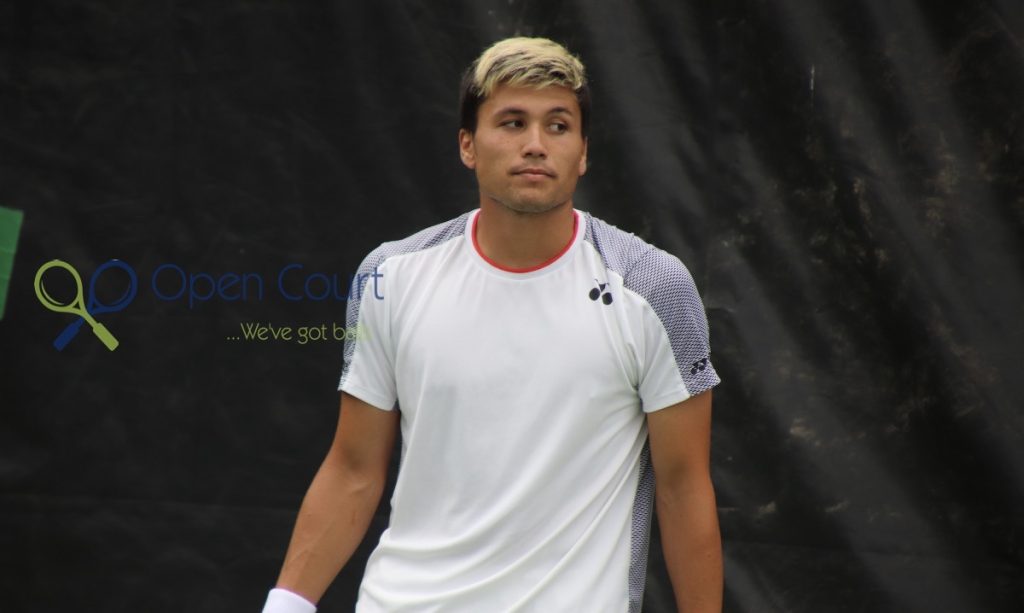
Santillan at the Granby Challenger in 2019
–
Tennis players change their nationality on a fairly regular basis – sometimes for money, or better opportunities, or to play Davis or Billie Jean King Cup where they might not make the cut in their own countries.
(This doesn’t always work – see Aljaz Bedene of Slovakia and Great Britain).
But Aussie/Japanese player Akira Santillan has been a bit of a yo-yo in that regard.
And as of last month, the No. 510 ranked player and former highly-regarded junior prospect – Alex de Minaur, Jordan Thompson and Alexei Popyrin were his contemporaries – has gone back from Australia to … Japan.
Santillan, now 28, was born in Japan to a Japanese mother and South African father. But he moved to the Gold Coast of Australia when he was eight.
According to the Australian, he represented Australia through his junior career until 2015, including carrying the flag in the junior Davis Cup in 2013. That included when he won the 2014 Canadian junior event, the big tuneup before the junior US Open.
And then he made the Australian Open junior boys’ semis the following January and switched to representing Japan “amid friction between his family and Tennis Australia”.
(It’s not hard to figure out what … that means).
But then, after Wimbledon in 2017, he decided he was Australian again.
“I’ve been playing for Japan for the last year-and-a-half, but I feel like I’m more Australian. I was brought up there and speak better English. Japanese is my first language, but most of my friends are Australian and I feel more comfortable being an Aussie,” he told the Australian. “I’m a fiery character on court, so it fits well. I made the decision at Wimbledon and I’m happy with it.”
(It was so long ago, Alejandro Tabilo of Chile and Filip Peliwo of Poland were still waving the Canadian flag).
Eight years an Aussie
Santillan went from Wimbledon, where he lost in the first round of qualifying to American Denis Kudla, directly to the Winnetka Challenger in Illinois – and won it. He reached his career high singles ranking of No. 144 at the end of that season.
Santillan is good pals with Nick Kyrgios. And he’s always been on our radar because of some drama at the Wimbledon qualifying in 2019.
Kyrgios, in lieu of practicing, spent much of the day at Roehampton supporting his mates, including Santillan and Tommy Paul.
And when Santillan completely lost it, after dropping a heartbreaker to Ruben Bemelmans of Belgium, he was there to offer counsel. And he even talked him into coming back the next day, to help cheer on Paul, in vain, in the final round.
(That’s Kyrgios peeking over the fence to the ending stages of Santillan’s defeat, which was 12-10 in the third set in the days before match tiebreaks – and a bleached blond Santillan the next day, when Paul lost a three-setter in the final round to Jiri Vesely).
Here’s what Santillan looked like during that match; he was unconsolable afterwards, blowing off the doping guy with the clipboard, and then making a mangled mountain of his tennis racquets.
Back to Japan
Fast foward eight years, with life not working out as planned – and Santillan is “Japanese” again.
His first tournament under his new-old flag came last month, a $30,000 ITF in Yinchuan, China. He won it. It bumped his prize money for 2025 just over the $15,000 mark, and his ATP ranking from No. 623 to No. 516.
We’re not sure where the benefit is, as the switch makes him the 21st-ranked Japanese player, where before he was the 24th-ranked Aussie.
What’s more noteworthy is that Santillan has been a full-time pro for more than a decade, averaging about $50,000 a year in earnings (about one-third of his total career earnings, $133,000, came all the way back in 2017). And yet, he plays just about every week; he’s played 18 tournaments this year in Turkey, Thailand and China, on just over $15,000 in prize money.
We do not know how these guys do it. Nor can we fathom how, a decade on and his once-viable dreams of being a top pro clearly faded, they still carry on.

More Stories
ATP Rankings Report – As of Oct. 20, 2025
WTA Rankings Report – As of Oct. 20, 2025
What a week for the Canuckians